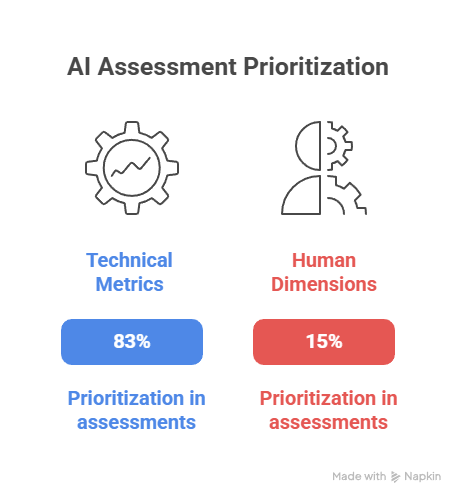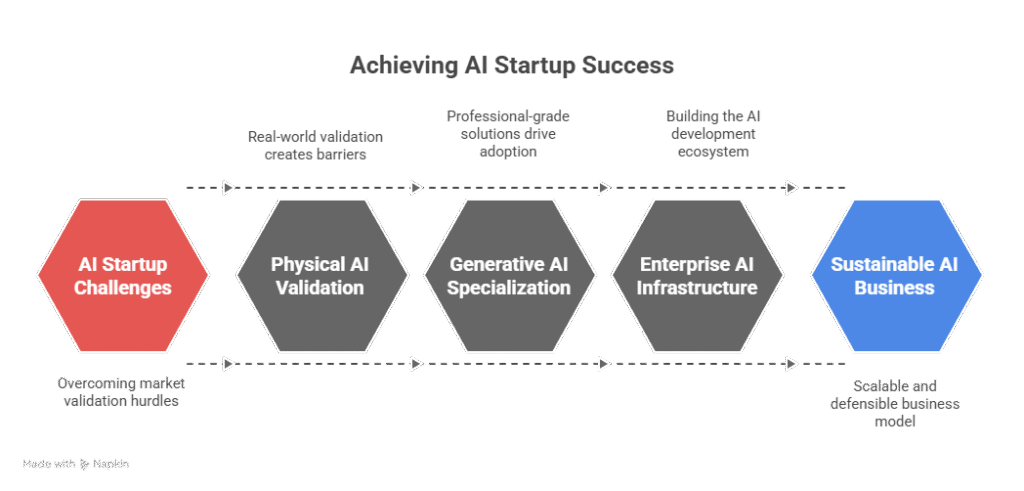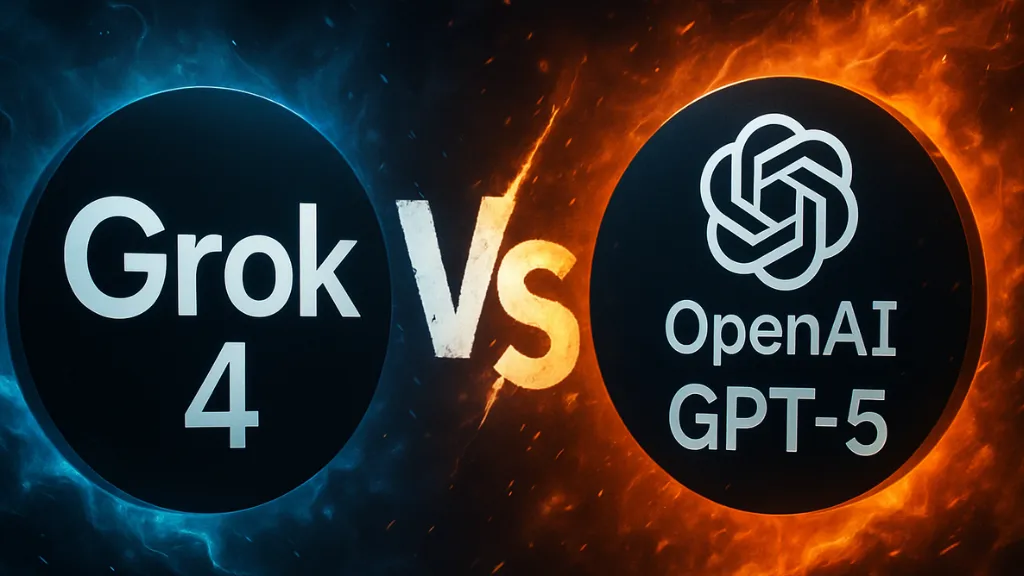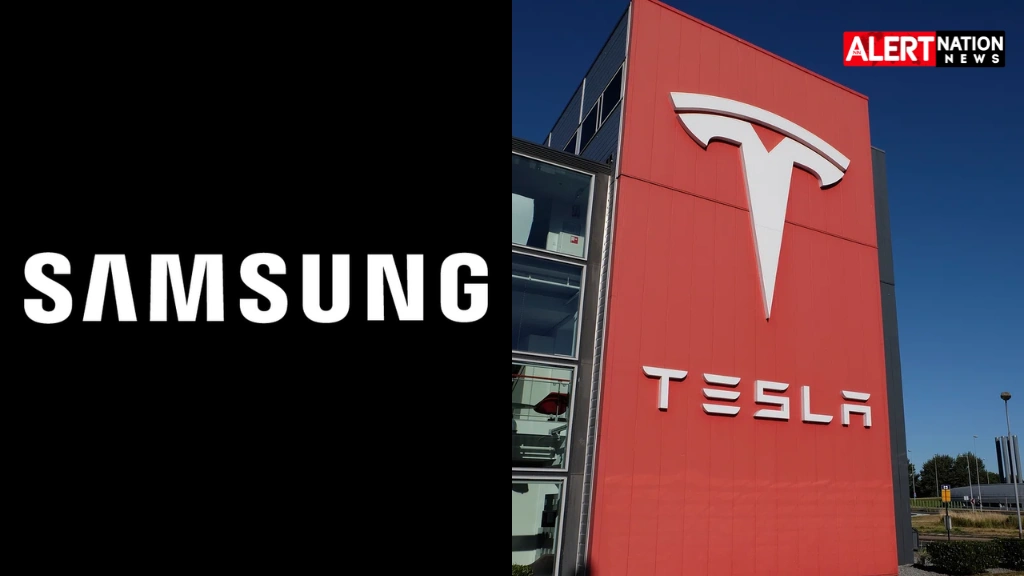Picture this: You’re a founder who just built an AI image editing tool that rivals Adobe’s latest features. Your product works flawlessly, your users love it, and you’re generating decent revenue. Then, overnight, Instagram releases a similar feature as part of their regular update, and suddenly, your entire business model crumbles. Welcome to the AI startup success benchmarks reality of 2025.
This isn’t a hypothetical scenario—it’s happening right now across Silicon Valley and beyond. The companies showcased at TechCrunch Disrupt 2025’s AI Stage, including pioneers from Apptronik, Hugging Face, Runway, Wonder Dynamics, and Wayve, represent the survivors who’ve figured out how to thrive in this brutal landscape.
The Hard Truth: Your Great Product Isn’t Enough for AI Startup Success Metrics
Let me share something that might surprise you about modern AI startup performance indicators. Traditional metrics that VCs have relied on for decades—those clean ARR charts and impressive NDR numbers—are becoming almost meaningless in the AI world. I read in a recent TechCrunch report about a portfolio company that hit $10M ARR in AI customer service, only to watch ChatGPT’s custom GPTs feature make their entire value proposition redundant in six months.
The problem? What investors now call “AI tourists”—users who eagerly try every new AI tool but jump ship the moment something shinier appears. Unlike traditional SaaS customers who stick around because switching is painful, AI users can literally copy-paste their data into a competitor’s tool and be up and running in minutes.
The measurement gap between technical achievements and real-world deployment value has become a critical issue, with current evaluation practices showing that 83% of AI assessments focus on technical metrics while only 15% incorporate both technical and human dimensions

This creates what I call the “AI paradox”: building has never been easier, but staying relevant has never been harder. The technical barriers to entry are lower than ever (thanks to open-source models and cloud APIs), but the competitive moats are becoming deeper and more specialized.
The Real AI Startup KPIs That Matter Now
Here’s what successful AI founders are actually tracking in 2025, according to recent venture capital research:
- Daily active engagement depth (not just usage frequency)
- Workflow embedding score (how painful it would be for users to switch)
- Data flywheel velocity (how quickly user data improves the product)
- Defensibility compound rate (how competitive advantages strengthen over time)
These aren’t vanity metrics—they’re AI startup success criteria for survival.
What VCs Are Actually Looking For in AI Startup Evaluation
I read in a recent Andreessen Horowitz analysis about their partner meetings where they reviewed 50 AI startups in two hours. The pattern was striking: companies with the flashiest demos got the least interest, while seemingly “boring” B2B tools with clear defensibility strategies got multiple follow-up meetings.

Here’s the five-point framework that’s actually driving AI startup investment criteria:
1. The Data Moat: Your Secret Weapon for AI Startup Competitive Advantage
Think about what makes Wayve different from every other autonomous driving company based on their recent Series C funding details. It’s not their algorithms (everyone has smart engineers). It’s their unique approach to collecting real-world driving data from actual customers in London traffic—data that becomes more valuable every day and literally cannot be replicated by competitors sitting in Silicon Valley offices.
Real example from Forbes: A startup in the legal tech space built an AI contract analyzer. Instead of competing on accuracy benchmarks, they focused on becoming the tool that legal teams use to train junior associates. According to their case study, they now have thousands of hours of expert lawyer feedback data that makes their models exponentially better at understanding legal reasoning—something no LLM trained on public text can match.
2. Technical Defensibility That Actually Matters for AI Startup Growth
Here’s a sobering reality from recent MIT Technology Review research: having a marginally better model isn’t defensible anymore. Anyone can fine-tune a foundation model and claim superior performance on cherry-picked benchmarks.
What works? Proprietary technical approaches that create systematic advantages. According to TechCrunch’s analysis of Apptronik’s Series A, they’re not just building better robots—they’re developing simulation-to-reality transfer systems that let them iterate 1000x faster than competitors who have to test everything in the physical world. That’s not just a better product; it’s a fundamentally different development cycle that compounds over time.
3. Workflow Integration That Creates Lock-In
I read in Stratechery about a founder who built an AI writing assistant that was technically superior to everything else on the market. Great writing, perfect grammar, creative suggestions. They failed within 18 months according to the case study. Why? Because their tool was just another text box that users copied and pasted from.
Compare that to successful companies like Notion AI or GitHub Copilot based on their user retention studies. These aren’t just AI features—they’re AI capabilities embedded so deeply into existing workflows that removing them would require users to completely change how they work. The best AI products don’t replace workflows; they become the workflows.
4. Problem Selection That Can’t Be Commoditized
Here’s something I wish more founders understood from reading recent Y Combinator batch analyses: not every problem needs an AI solution, and not every AI solution solves a real problem. The companies that survive are those solving fundamental business challenges where AI isn’t just nice-to-have—it’s the only viable solution.
Wonder Dynamics figured this out perfectly, according to their Series A announcement. They’re not building “AI for filmmakers” (too broad, too competitive). They’re solving the specific problem of VFX democratization for independent creators who can’t afford $100,000 motion capture setups. That’s a real problem with clear economic benefits, where AI enables something previously impossible.
5. Business Models That Scale With Intelligence
The dirty secret of many AI startups from recent Bessemer Venture Partners research is that their business models don’t actually benefit from getting smarter. They charge per API call or monthly subscriptions that don’t reflect the increasing value their AI provides.
The winners charge for outcomes, not outputs. According to Runway’s recent funding coverage, they don’t just charge for video generation—they’re building toward charging for creative production value. Their pricing scales with the sophistication of what you create, not just how much compute you use.
Industry Spotlights: What’s Actually Working for AI Startup Success Factors

Physical AI: Where the Real Money Is
Reading through Boston Dynamics’ recent acquisition reports, I realized something profound: while everyone’s fighting over chatbot market share, the real AI revolution is happening in the physical world. Apptronik’s recent $350M Series A, according to Crunchbase, isn’t just impressive—it’s a signal that investors finally understand physical AI’s potential.
What makes physical AI startups successful, based on recent industry analysis:
- Real-world validation requirements that create natural barriers to competition
- Safety-first development that builds trust with enterprise customers
- Partnership-dependent scaling that creates business model defensibility
When Mercedes-Benz partners with Apptronik for their manufacturing lines, according to their press release, that’s not just a customer relationship—it’s a multi-year technical integration that competitors can’t easily replicate.
Generative AI: Beyond the Hype Cycle for AI Startup Benchmarks
Remember when everyone was building “ChatGPT for X”? Most of those companies are dead now, according to CB Insights data. Runway survived and thrived (recent $1.5B valuation per PitchBook) because they understood something crucial: generative AI success isn’t about general capability—it’s about specific, professional-grade solutions.
I read in AdAge about a creative director at a major advertising agency who explained why they pay for Runway instead of using free alternatives: “It’s not just about generating videos. It’s about generating videos that match our brand guidelines, integrate with our existing tools, and maintain consistency across campaigns.” That’s the difference between a feature and a platform for AI startup market validation.
Enterprise AI: The Sustainable Path
Hugging Face’s approach fascinates me based on their recent Sequoia Capital funding coverage because they’ve solved the classic AI startup dilemma: how do you build a sustainable business in an open-source world? Their answer: become the infrastructure that everyone builds on top of.
According to their growth metrics, they’re not just hosting models—they’re creating the ecosystem where AI development happens. Every model uploaded, every dataset shared, every developer who learns on their platform increases the value for everyone else. That’s a true network effect in action for AI startup scalability.
How to Actually Stand Out Beyond the Obvious Advice
Build Your “Bailey and Motte” Strategy for AI Startup Success

This is a medieval castle defense concept that applies perfectly to AI startups, according to recent a16z essays. Your “bailey” is your fast-to-deploy competitive advantages—better distribution, faster shipping, superior user experience. These get you market traction quickly but aren’t permanently defensible.
Your “motte” is your core defensibility—proprietary data, technical breakthroughs, or deep customer integrations that become nearly impossible to attack as you grow. Smart founders build both simultaneously for optimal AI startup growth metrics.
Case study from Harvard Business Review: A startup that built AI for customer support had their bailey as launching integrations with every major helpdesk tool in 60 days. Their motte was using every customer interaction to build industry-specific knowledge graphs that became more valuable with scale. The bailey got them customers; the motte kept them.
Focus on Real-World Messiness in AI Startup Performance
Academic AI benchmarks are clean, controlled, and completely divorced from reality, according to recent Stanford AI Index research. Real-world deployment is messy, contextual, and full of edge cases that break your perfect models.
I read about this lesson in MIT Sloan Management Review through an AI recruiting tool case study that failed spectacularly despite perfect accuracy on hiring prediction benchmarks. The problem? Their model couldn’t handle the human complexities of hiring—cultural fit, team dynamics, growth potential—that actually determine success.
The companies that win optimize for real-world performance, not benchmark performance when it comes to AI startup success measurement.
Create Personal Utility Network Effects
This is perhaps the most counterintuitive insight from recent OpenAI research: the best AI products feel personal but actually get better through collective usage. ChatGPT feels like a private conversation, but every interaction helps train models that improve everyone’s experience.
Design your product so that individual usage creates collective value for superior AI startup competitive positioning. The more someone uses your AI assistant, the better it should get—not just for them, but for similar users in similar contexts.
The Regulatory Reality Check for AI Startup Success Benchmarks
Let’s talk about something most founders are ignoring based on recent McKinsey reports: regulation is coming, and it’s going to determine winners and losers. The EU’s AI Act, emerging US federal guidelines, and industry-specific requirements aren’t distant threats—they’re current reality for any startup wanting enterprise customers.
I read in Forbes about founders who spent months building beautiful AI products only to discover they can’t sell to healthcare companies because they didn’t build audit trails from day one. Meanwhile, their “boring” competitors who designed for compliance from the start are signing million-dollar contracts according to the case studies.
Build compliance as a competitive advantage, not a cost center for long-term AI startup success factors.
Looking Forward: The Long Game for AI Startup Growth
Here’s what I believe after reading through hundreds of AI startup case studies over the past three years: the current wave of AI excitement will consolidate into a smaller number of category-defining companies. The question isn’t whether you’ll face competition from OpenAI, Google, or Meta—it’s whether you’ll be building something they’ll want to acquire or something they’ll destroy by accident.
The founders who succeed will be those who understand from recent Sequoia research that AI is not a destination—it’s infrastructure for solving real problems. They’ll build businesses that become more defensible over time, not less. They’ll create value that compounds, not commoditizes, for sustainable AI startup performance metrics.
The future belongs to AI startups that make themselves indispensable, not just impressive. In a world where anyone can build AI according to recent Gartner analysis, the winners will be those who build AI that no one else can replace.
The companies featured at TechCrunch Disrupt 2025’s AI Stage aren’t just riding the AI wave—they’re the ones building the surfboards that everyone else will need to stay afloat. The question is: will you be building surfboards, or will you be swimming in the wake of those who do?
Remember: in the AI game, being first to market means nothing if you’re not first to create something truly defensible. The race isn’t to the swift—it’s to the indispensable when measuring AI startup success benchmarks.






